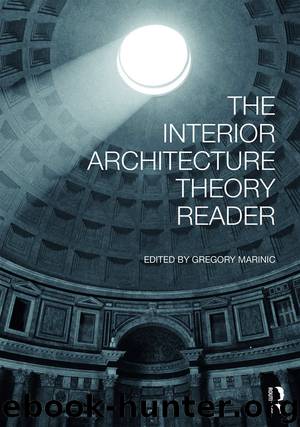The Interior Architecture Theory Reader by Gregory Marinic

Author:Gregory Marinic
Language: eng
Format: epub
Publisher: Taylor and Francis
Published: 2017-12-22T16:00:00+00:00
Orthographic projection
Orthographic projection is the fundamental drawing system in interior architectural design for grounding a project in true measurement in order to convey information to builders. The system provides a universal form of visual communication by utilizing a set of variables that have reached a level of objectivity. The evolution of this drawing type relies upon a clear set of rules whereby a field of parallel lines meets a perpendicular surface. Plan, section, and elevation inform one another across invisible hinges that result in a collection of two-dimensional views folded up to convey a three-dimensional form.
The perpendicular relationship is neutral until the draughtsperson activates the latent field of invisible parallel lines received by the passive surface patiently awaiting the drawn line, also known as the picture plane. The receiving surface is meant to be flat in order to record the lines with precision, otherwise a ripple in the picture plane would disrupt the rules and potentially cause misinterpretation. The parallel lines can be seen as a collection of points that appear on the paper and assist the draughtsperson in realizing a design, but at a scale that is manageable at the size of a desk. Point, line, and plane help translate back and forth between one, two, and three dimensions, where the point can be seen as the fundamental element upon which everything else is built. What appears as a point or line in one drawing (such as a plan), may appear as a plane in another drawing (elevation), hence the need for multiple views in order to piece together an understanding of the whole. As the design appears on paper, the drawing requires that the form being recorded hold still, as if being drawn for a still life. This works for static elements but is unaccepting of the temporary and fleeting. This matters not so much for architecture, but it matters in interior design, where the practice is responsible for designing the temporary and fleeting. Time is a variable inherent to the temporal, but absent from this drawing type. With these variables and rules in place, how can the designer integrate the temporal? The next section of this chapter will use dance as a means of highlighting temporal movements of occupants to probe where the orthographic system supports or breaks from allowing the temporal to enter into the drawing.
Download
This site does not store any files on its server. We only index and link to content provided by other sites. Please contact the content providers to delete copyright contents if any and email us, we'll remove relevant links or contents immediately.
| Automotive | Engineering |
| Transportation |
Whiskies Galore by Ian Buxton(41880)
Introduction to Aircraft Design (Cambridge Aerospace Series) by John P. Fielding(33064)
Small Unmanned Fixed-wing Aircraft Design by Andrew J. Keane Andras Sobester James P. Scanlan & András Sóbester & James P. Scanlan(32743)
Craft Beer for the Homebrewer by Michael Agnew(18140)
Turbulence by E. J. Noyes(7936)
The Complete Stick Figure Physics Tutorials by Allen Sarah(7307)
Kaplan MCAT General Chemistry Review by Kaplan(6867)
The Thirst by Nesbo Jo(6828)
Bad Blood by John Carreyrou(6552)
Modelling of Convective Heat and Mass Transfer in Rotating Flows by Igor V. Shevchuk(6391)
Learning SQL by Alan Beaulieu(6211)
Weapons of Math Destruction by Cathy O'Neil(6146)
Man-made Catastrophes and Risk Information Concealment by Dmitry Chernov & Didier Sornette(5921)
Digital Minimalism by Cal Newport;(5664)
Life 3.0: Being Human in the Age of Artificial Intelligence by Tegmark Max(5474)
iGen by Jean M. Twenge(5366)
Secrets of Antigravity Propulsion: Tesla, UFOs, and Classified Aerospace Technology by Ph.D. Paul A. Laviolette(5309)
Design of Trajectory Optimization Approach for Space Maneuver Vehicle Skip Entry Problems by Runqi Chai & Al Savvaris & Antonios Tsourdos & Senchun Chai(5011)
Pale Blue Dot by Carl Sagan(4912)
